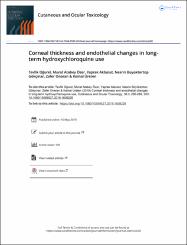| dc.contributor.author | Oğurel, Tevfik | |
| dc.contributor.author | Özer, Murat Atabey | |
| dc.contributor.author | Akbulut, Yaprak | |
| dc.contributor.author | Gökçınar, Nesrin Büyüktortop | |
| dc.contributor.author | Onaran, Zafer | |
| dc.contributor.author | Üreten, Kemal | |
| dc.date.accessioned | 2020-06-25T18:34:04Z | |
| dc.date.available | 2020-06-25T18:34:04Z | |
| dc.date.issued | 2019 | |
| dc.identifier.citation | closedAccess | |
| dc.identifier.issn | 1556-9527 | |
| dc.identifier.issn | 1556-9535 | |
| dc.identifier.uri | https://doi.org/10.1080/15569527.2019.1608228 | |
| dc.identifier.uri | https://hdl.handle.net/20.500.12587/7785 | |
| dc.description | Gokcinar, Nesrin Buyuktortop/0000-0001-7795-5188 | en_US |
| dc.description | WOS: 000469731800001 | en_US |
| dc.description | PubMed: 31010339 | en_US |
| dc.description.abstract | Objective: To determine possible associations between long-term HCQ use and corneal changes in patients who used HCQ for at least 3 years. Materials and methods: The study included 62 healthy controls and 62 consecutive patients who used HCQ for the treatment of rheumatologic disease and were referred to the ophthalmology department between August 2018 and November 2018 for HCQ retinal toxicity screening. Central corneal thickness (CCT), corneal endothelial cell density (ECD), the coefficient of variation (CV) of cell size, and the percentage of hexagonal cells (HEX%) were measured to evaluate changes in the cornea. Results: The mean age of the patient group and control group was 50.10 +/- 10.91 and 50.53 +/- 10.67 years, respectively. The mean ECD was 2742 +/- 347 (cells/mm(2)) in the patient group and 2875 +/- 188 cells/mm(2) in the control group. There was a significant difference between groups (p = 0.01). The mean CCT was 567.05 +/- 32.35 mu m in the patient group and 540.15 +/- 38.50 mu m in the control group. CCT was significantly higher in the patient group compared with control group (p < 0.001). There was no significant difference between groups in terms of mean CV and HEX values (p > 0.05). Conclusions: Patients using long-term HCQ demonstrated lower ECD and higher CCT than the control group. However, the CV of cell sizes and the HEX % values were not significantly different from the controls. | en_US |
| dc.language.iso | eng | en_US |
| dc.publisher | Taylor & Francis Ltd | en_US |
| dc.relation.isversionof | 10.1080/15569527.2019.1608228 | en_US |
| dc.rights | info:eu-repo/semantics/closedAccess | en_US |
| dc.subject | Hydroxychloroquine | en_US |
| dc.subject | corneal thickness | en_US |
| dc.subject | endothelial cell density | en_US |
| dc.title | Corneal thickness and endothelial changes in long-term hydroxychloroquine use | en_US |
| dc.type | article | en_US |
| dc.contributor.department | Kırıkkale Üniversitesi, Tıp Fakültesi, Cerrahi Tıp Bilimleri Bölümü | en_US |
| dc.identifier.volume | 38 | en_US |
| dc.identifier.issue | 3 | en_US |
| dc.identifier.startpage | 286 | en_US |
| dc.identifier.endpage | 289 | en_US |
| dc.relation.journal | Cutaneous And Ocular Toxicology | en_US |
| dc.relation.publicationcategory | Makale - Uluslararası Hakemli Dergi - Kurum Öğretim Elemanı | en_US |
















